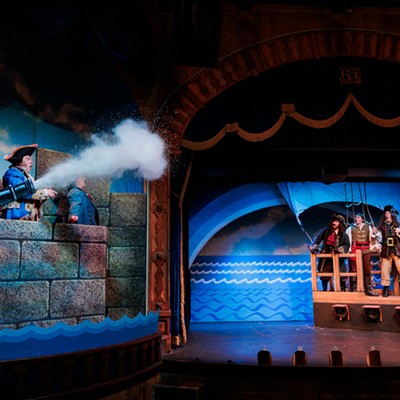Attractions include the Arizona Historical Society Museum Downtown's exhibit of the Dillinger gang's confiscated arsenal and mug shots, Hotel Congress' educational tours and a re-enactment of the capture.
Dillinger was arrested, as were Harry Pierpont, Russell Clark and Charles Makley. But they were not the only individuals captured. Tucson authorities also arrested Evelyn "Billie" Frechette, Opal Long and Mary Kinder. The press labeled them "molls," indicating that they were loose women who hung around gangsters.
But according to Ellen Poulsen, author of Don't Call Us Molls: Women of the John Dillinger Gang, the women in Dillinger's inner circle were not floosies or women of leisure. Poulsen will speak on "The Three Women of Dillinger's Days: Love, Loyalty and Loss," at 1 p.m., Saturday, Jan. 19, at Hotel Congress' Copper Hall, 311 E. Congress St. For a complete schedule of Dillinger Days events, which run between 10:30 a.m. to 5 p.m., on Saturday, Jan. 19, visit www.downtowntucson.org/dillinger_days. "They had a lot to do. They were entrusted with the job of keeping the gang in touch with each other. The gang always split up and took different apartments. There was sometimes very little communication between them. The women would (coordinate phone calls) in pool halls," says Poulsen.
Dillinger's girlfriend, Evelyn "Billie" Frechette, had additional responsibilities. "She purchased cars in the name of Mrs. Frank Sullivan. (Sullivan was an alias Dillinger used.) She rented apartments and opened up bank safe-deposit box (accounts) to hide the loot. She was also a good driver. She once drove a car away as police were shooting at them."
While female criminals weren't unheard of at the time--Bonnie Parker (of Bonnie and Clyde) was killed in 1934--historians don't often focus on the women of Dillinger's gang. Poulsen says she wasn't able to find a lot of information about the women and wanted to know more.
As she researched, Poulsen saw a common thread between Dillinger's women--economics.
"It was the Depression. They didn't have money. They had decent upbringings and were educated. But they were in bad company and schooled in crime. Gangsters and bootleggers were the only men with money. It was either that, or go out with the guy who stood in line for bread and apples," says Poulsen.
Both Long and Frechette were especially motivated to provide for their families. Long helped provide money for her sister's child.
Frechette was of French and Native American decent and spent part of her childhood on a Menominee reservation in Wisconsin. She attended high school in South Dakota.
"After graduating high school, she went back to the reservation and was bored by the local scene. She went to Milwaukee and then drifted into Chicago. Evelyn worked at a speakeasy in Chicago and was a hat-check girl. She had developed a tendency to take up with fast men and fast cars. ... Dillinger was just one more guy who had money and helped her with her finances so she could send something home to the reservation," says Poulsen.
After Dillinger was killed, Mary Kinder went on tour with members of Dillinger's family as part of the Crime Does Not Pay Show.
"It started in August or September 1934. They traveled to carnivals and theaters and talked about the dummied-down reality of life with the gang. Evelyn joined in 1936. She'd stand up and talk about simple things, such as, 'John liked bread and gravy. John liked movies.' It was entertainment," says Poulsen.
However, they didn't get away with their criminal misdeeds. Frechette and Long served time behind bars, and Kinder lived through the heartbreak of the execution of her boyfriend, Harry Pierpont.
"They all paid for their crimes. In no means were these glamorous characters," says Poulsen.
Despite the hardships and heartbreak suffered by the Dillinger women and their men, their lives and the era in which they lived are sometimes viewed in a favorable light.
"People have a fond nostalgic association with the era," says Donovan Durband, executive director of the Downtown Tucson Partnership. "With the costumes and old cars ... it is kind of romanticized."
Durband says the re-enactment at Dillinger Days is popular to watch.
"Act I starts with the crime spree in the Midwest and includes the gang's arrival in Tucson. It explains the story of why they came to Tucson to lay low. They assumed they would not get caught in the desert. Act II gets into the events that led to their capture in Tucson. It's a dramatic re-enactment with action, dancing and music," says Durband. Other free offerings include live music and entertainment by Carl Hanni (a frequent Tucson Weekly contributor), The Dusty Buskers, Tom Walbank and the Ambassadors, Emilie Marchand, Al Perry and The Cattle and Tony Frank. Other lectures, walking tours of downtown, films at the Historic Train Depot and exhibits at the Postal History Foundation and Southern Arizona Transportation Museum round out the events.







